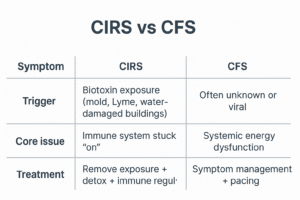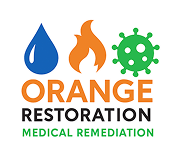“Many people living with fatigue, brain fog, or chronic illness may actually be dealing with Chronic Inflammatory Response Syndrome (CIRS), an Environmental factor impacting health, not just stress or aging.” -Medically Sound Remediators
Dr. Ritchie Shoemaker first described CIRS after observing patients from water-damaged buildings with mysterious, lingering illnesses that conventional tests couldn’t explain.
We often hear from clients “My family thinks I’m crazy but I know something’s wrong” and “Every doctor says my labs are normal but I’m not” as they are navigating an environmental toxic soup that many professionals do not consider in their diagnosis.
Dr. Shoemaker’s discoveries shed light on what many of our clients already know intuitively, something in their environment is making them sick. Yet, for years, these symptoms have been mislabeled as stress or depression.
CIRS diagnosis is still new to the medical field, but the data from EPA and professionals like Dr. Shoemaker are combining to influence the medical revolution to include environmental factors into medical diagnosis. EPA reports that 50% of our buildings are classified as water damaged, while Dr. Shoemaker’s data shows that 80% of his CIRS patients have had continued exposure to water damaged buildings.

When Fatigue Isn’t Just Fatigue
If you’ve been told your fatigue is ‘just stress,’ ‘just aging,’ or ‘just in your head,’ you’re not alone. Many people living with persistent exhaustion, brain fog, and unexplained symptoms are actually dealing with something much deeper, a chronic inflammatory response called CIRS.
The Overlap Between CIRS and Chronic Fatigue
While Chronic Fatigue Syndrome (CFS or ME/CFS) and Chronic Inflammatory Response Syndrome (CIRS) can look nearly identical, their root causes, and how they’re treated, are very different.
Both CIRS & CFS conditions share:
- Profound fatigue not improved by rest
- Brain fog and cognitive issues
- Muscle pain and weakness
- Sleep disturbances
- Dizziness or postural intolerance
- Anxiety, mood swings, or depression
- Sensitivity to light, sound, or chemicals

CIRS VS CFS Symptoms and treatment differences.
Here’s the key difference between CIRS and CFS:
CIRS has a biotoxin trigger (usually mold, Lyme, or water-damaged building exposure) and the body’s immune system can’t properly “turn off” inflammation after the exposure ends. Many might not mention a tick bite to their doctor when dealing with exhaustion. They may be dismissive of the mold their home has constantly battled, but this is the terrain of their health daily. The water damaged building is constantly discussed as if it is not really damaged, “it is still a home” denial of the problem, but is it the root cause of the health problem?
Mold Exposure can Trigger Inflammatory Cascade
CIRS is that answer for some patients who have been around the diagnosis wheel to find none of it was the root problem. There were multiple symptoms of the much larger chronic illness, CIRS was the root diagnosis and environmental factors being the culprit.
Chronic Fatigue Syndrome doesn’t have a root cause like CIRS. Mold and water damaged buildings are environmental. This means CIRS patients have some control over their healing. This can provide some hope, if you have been diagnosed with any chronic illness, knowing that you can remove the cause and it is all external, means you can get out alive! Often, however, CIRS patients may still have deep mold contamination in their lungs and bodies.
If your fatigue hasn’t improved despite countless tests and treatments, it may be time to look at your environment. Our team specializes in medically sound remediation, helping you identify and eliminate the environmental triggers your body can’t escape.
CIRS Healing and Hope
If you’ve been struggling with chronic fatigue or unexplained health issues, it might not be “all in your head.” CIRS bridges the gap between environmental science and medicine, and identifying your environment’s role could be the missing piece to recovery.
